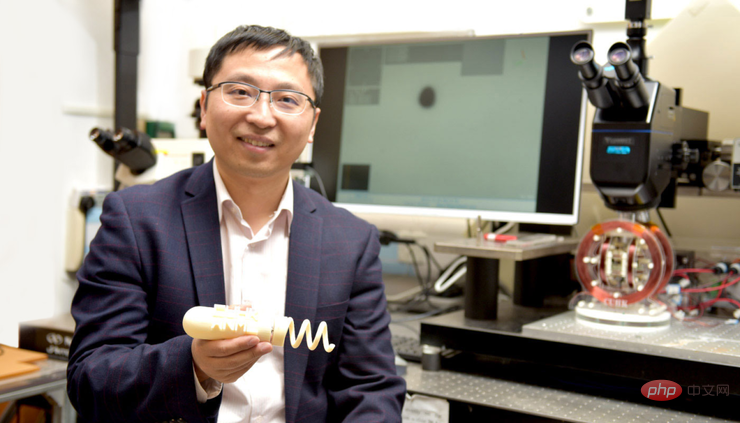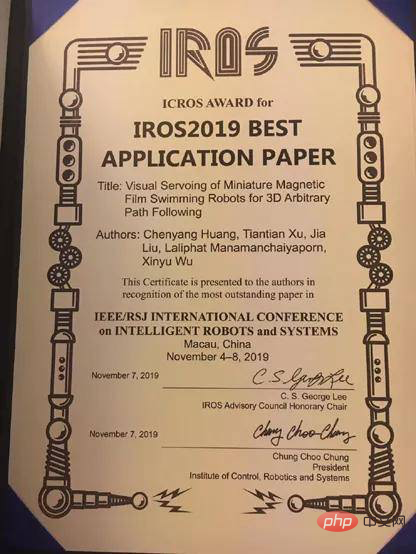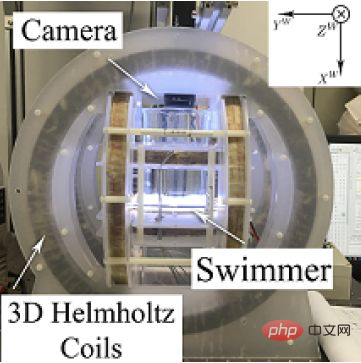Feynman's Rhapsody: The 'surgeon' who can enter the body
In 1959, Nobel Prize winner in physics Richard Feynman gave a lecture at the California Institute of Technology entitled "There is Plenty of Room at the Bottom" (There is still a vast space for bottom-level research) ’s speech first envisioned the possibility of microrobots inside the body.
In Feynman’s conjecture, this type of micro-robot is driven by Micro-Electro-Mechanical System (MEMS) and can enter the body to perform surgery. At that time, Feynman said: "If we can swallow a surgeon, then many complex operations can become very interesting and simple."
Perhaps Feynman's influence is too great. In ten years Later, before the scientific research community could conduct research, American director Richard Fleischer made Feynman's idea into a classic science fiction movie, "Fantastic Voyage." In the movie, five doctors were reduced to one millionth of their original size and injected into the body of a life-threatening patient whose cerebral blood vessels were damaged. After a series of adventures, they finally succeeded in finding the bleeding point and saving him in time. took the life of the patient.
But, can micro-robots that can enter the human body only be a fantasy? The answer is obviously doubtful.
Since Feynman proposed the concept of "in vivo surgeon", scientists have been attracted and inspired by this idea, invested in the research of microrobots, and achieved many good results. Scientists imagine that in the future, machines can really enter the human body to achieve targeted therapy and drug delivery, and help treat major diseases such as tumors.
1. "Slime" Robot
Some time ago, a magnetically controlled slime micro-robot called "Slime" became popular on New Scientist.
It is made of magnetic mucus material and can be entered into the body to remove small devices accidentally swallowed. As soon as it was released on April 1, it immediately caused a huge sensation in the technology community. Netizens were shocked and the click rate quickly exceeded 100,000, 1,000,000, and 10,000,000:


It should be noted that the "Slime" robot currently does not have the ability to move autonomously. Its movement and expansion rely on the external magnetic field to control the neodymium magnet inside (which can be understood as a "powerful small magnetic ball").
"The 'Slime' robot itself has no fixed shape. It is slime-like. When a magnetic field is added, it will respond to the magnetic field. If you move the magnet from left to right, it will follow Hold the magnet from left to right. Due to the size of the magnetic force, it can easily change its shape. For example, if someone accidentally swallows a harmful component, turn it into a hand and grab the package." Zhang Lixiang commented on AI Technology introduce.
This is also the first time that the Advanced Nanomaterials & Microrobotics Laboratory (ANML) led by Zhang Li has produced a magnetic slime robot. Previously, ANML has produced many different types of micro nanorobots, including bionic insect robots printed with 3D technology, all of which are remotely controlled based on magnetic fields. "But slime-like robots like the 'Slime' robot have such large deformations." , it can be rolled up like an elephant's trunk, this is the first time." Zhang Li said.
What’s even more amazing is that it only took half a year for Sun Mengmeng, the first author of the work and an in-service postdoctoral fellow in the ANML laboratory, to join ANML, start research and development, and publish the article.

Illustration: Dr. Sun Mengmeng
"This is mainly because Sun Mengmeng already had some knowledge when he was a PhD student at Harbin Institute of Technology (under the tutelage of Professor Xie Hui). Idea. After coming here, with the help of our research group’s extensive experience in related materials and magnetic control operations, the project progressed smoothly." Zhang Li introduced.
Considering the complexity of the internal environment of the human body, Zhang Li’s team imagined that the “Slime” robot might have a certain application space in the digestive tract. There are several main reasons: First, the cavity of the digestive tract If it is larger, the "Slime" robot will shuttle more smoothly inside; secondly, the human digestive tract already has many microbial flora, so the risk of trying a robot inside the body is relatively low; thirdly, the materials used to make the "Slime" robot After cytotoxicity testing, the toxicity is low. If it only stays in the body for a short time and is excreted, it is theoretically safe.
Of course, the idea of using "slime" robots as internal treatment actuators is still at the conceptual stage and needs further exploration.
2. Development of micro-robots inside the body
The performance of "slime" robots is gratifying, but looking back at the development history of such micro-robots that can enter the body, it only lasts a few decades.
In the 1970s, in order to promote classified research, the U.S. intelligence agency tried to design some micro-robots that could perform prisoner-of-war assistance and electronic interception tasks. However, because the underlying supporting technology was not fully developed at the time, the micro-robot prototypes were not developed. Nothing was developed from this early set of calculations and concepts.
It was not until the 21st century that microrobots were officially launched. With the development of multidisciplinary fields such as microelectromechanical and microactuators, microrobots have achieved important technological breakthroughs and gradually become an international research hotspot.

Illustration: Bionic Micro Robot
Compared with large robots that have been studied for more than half a century, the development of micro robots only lasts for more than 20 years. There are only a handful of "microrobots that can enter the body", and they are in their infancy both at home and abroad.
There are different categories of micro robots. Among them, micro medical robots are considered by the industry to be the most promising application field. The Japan Science and Technology Policy Research Institute has predicted that “in the future, surgeries using microrobots and robots in the medical field will account for more than half of all medical surgeries.”
Abroad, Japan has taken the lead in adopting the "robotic surgeon" plan and is developing ultra-miniature robots that can travel through human blood vessels to find and kill cancer cells. The John Hopkins Laboratory in Maryland, USA, has developed a miniature detection device equipped with a miniature silicon thermometer and a miniature circuit. When swallowed into the body, the body's temperature information can be sent to a recorder. Swedish scientists have invented a robot that is as big as an English punctuation mark. In the future, it can move single cells or capture bacteria to perform various surgeries in the human body.
Domestic researchers have also paid attention to this cutting-edge direction early, such as Professor Sun Lining of Suzhou University and Professor Liu Lianqing of Shenyang Automation Research Institute. In the field of "in vivo robots", young scholars such as Zhang Li, a professor at the Chinese University of Hong Kong, and Xu Tiantian, a researcher at the Shenzhen Institute of Advanced Technology, are not far behind, exploring new opportunities from the two major directions of materials and control.
In general, there are three major elements for the realization of robots in the body: first, the realization of a "micro" body shape; second, safety materials that adapt to the internal environment; third, the "automatic operation of the robot inside the body" driving skills.
Take the "Slime" robot as an example. Its biggest breakthrough is the material. It uses polyvinyl alcohol and borax materials with non-Newtonian fluid characteristics, plus a layer of silica. Its viscosity changes with contact with the outside world, and it has high adaptability to the environment. It can be used in gaseous, liquid and solid environments. Both can extend and crawl, and can perform multi-modal manipulation.

Illustration: Pour non-Newtonian liquid into the pool to float on the water
However, the toxicity safety of borax has not yet been guaranteed, and this field is currently A focus of research is to identify materials more suitable for building tiny medical robots. The material must be flexible, skin-friendly, non-toxic, harmless, easy to eliminate from the body, and easy to operate.
Regarding innovation and safety, Professor Zhang Li’s view is: “Sometimes scientists and doctors have different ideas. Doctors are often more conservative and often consider safety first, while scientists emphasize innovation more. There is a certain contradiction between the two." But in medical scenarios, there is no doubt that safety must be the first priority.
In addition to materials, controlling the path of microrobots in the body is another problem that needs to be solved urgently to become a "surgeon". In recent years, the research focus of in vivo microrobots has experienced three stages of changes: from open-loop control to closed-loop control, from a single motion mode to multiple motion modes, and from a single robot to multiple robots. The control of micro-robot clusters has practical application value in in-vivo medical scenarios and is also a major research trend in the field of robotics.
Compared with a single robot, cluster microrobots have two major advantages:
First, reduce the failure rate. For example, for drug delivery, the drug loading dose of swarm robots can be increased. In addition, in environments such as blood, a single tiny robot can easily be washed away by blood or engulfed by macrophages. At this time, switching to a swarm of robots can improve the success rate of treatment;
The second is swarming Easy to observe. Today's robots can reach nanometer scales, but when they are placed inside the body, it is extremely difficult to clearly observe a single robot using existing medical imaging equipment. Just like diving, we tend to ignore a small fish swimming in front of us, but we are often shocked by a group of dark fish in the distance.
3. Path control: "driving" in the body
In terms of path control of micro-robots, Xu Tiantian, a researcher at the Shenzhen Institute of Advanced Technology, Chinese Academy of Sciences (referred to as "Shenzhen Institute of Advanced Technology") is an expert. A “new star” in scientific research.
Xu Tiantian comes from a background in automation control. He received his master's and doctorate degrees from the Ecole Centrale de Paris and the University of Paris VI. He began researching micro-robots during his Ph.D. After graduating with her PhD in 2014, she joined Professor Zhang Li's team at the Chinese University of Hong Kong as a postdoctoral researcher. In 2016, she officially joined the Intelligent Bionic Center of the Institute of Integration, Shenzhen Advanced Institute of Technology. She is currently the only scientist at Shenzhen Advanced Institute of Technology who studies the path control of medical microrobots.

Illustration: Researcher Xu Tiantian, Shenzhen Institute of Advanced Technology
From Professor Xu Tiantian’s perspective, research on path control of microrobots in vivo can be roughly divided into three directions. : First, how to make micro-robots move inside the body? The second is how to make them move according to the established path? Third, how to adapt them to the complex environment in the body?
If microrobots are compared to cars, then the suspended movement of the robot inside the body is equivalent to controlling a car to drive in the air in a complex and busy city. It is extremely difficult and has extremely high safety risk factors.
It should be noted that many physical laws in the microscopic world are different from those in the macroscopic world. For example, in 1976, Nobel physicist E.M. Purcell proposed the "scallop theorem", which means that when a scallop opens its shell quickly and then slowly closes it, due to inertia, the scallop will jump forward when it is opened quickly. It forms a "movement forward" that runs one after another. However, in the microscopic world, since the inertial force is almost negligible in the face of viscosity, the opening and closing actions of the scallop cannot move it forward.

#The internal environment of the human body is also a microscopic world. How to make microrobots move inside the body?
Xu Tiantian worked with the team to draw inspiration from nature: one is E. coli, which is driven forward by a spiral tail, just like twisting a screw, turning and moving forward; the other is flexible sperm Vibrate, vibrate forward by flapping its tail. In these two ways, they successfully created spiral-shaped robots and sperm-shaped bionic robots, and successfully made the robots move in an environment that mimics the environment inside the body.

Illustration: The micro-robot moves forward by "spiral swimming" in the liquid
However, it is not enough to make the robot move inside the body. It is necessary to ensure that the forward path is safe and cannot run rampant inside the body...
Therefore, in order to ensure that the robot shuttles "accurately" in the body, bypasses dangerous areas, and ensures safety, the path control of micro-robots is studied appears particularly important. And as mentioned before, the robot operates in the body by "moving forward in the air," which requires the robot to have 3D movement capabilities.
In 2019, Xu Tiantian’s team proposed a new type of path following control algorithm, which uses the path differentiation method to differentiate any given path into various small segments, allowing it to find its nearest small segment at each point. , to control its forward direction. Their algorithm successfully realized 3D path control for millimeter-level magnetically driven soft robots. The related work won the IEEE International Conference on Intelligent Robots and Systems (IROS) Best Application Paper Award:

In terms of path control, Xu Tiantian’s team also adopts magnetic control. The main advantage of magnetic control is that it can be controlled wirelessly: if the robot enters the body, a human researcher or doctor can perform the operation outside the body. At the same time, the magnetic control has a short response time, high power density, and high repeatability. The robot can successfully reach the lesion multiple times, eliminating the randomness of the success rate.

Note: Xu Tiantian’s team’s multi-degree-of-freedom magnetic control device
After realizing the 3D path control of a single robot, Xu Tiantian and his team turned to multi-robot control. Collaborative control research advances.
Xu Tiantian explained to AI Technology Review that there are two major difficulties in the operation of micro-robots based on magnetic control: First, the input signals in the same magnetic field are the same, which will lead to the direction of movement of multiple micro-robots. It is consistent with the speed; second, there is a lack of communication between micro-robots and they cannot be controlled independently.
In order to solve this problem, Xu Tiantian and his team have studied for many years, and finally achieved results at the beginning of this year-
They proposed a completely decoupled method that does not require communication and uses external unified signals. To perceive the robot and solve the problem of how to produce different outputs for the same signal, it achieved the independent position control of four magnetic soft micro-robots and the independent path following control of three magnetic soft micro-robots for the first time. Related work ("Independent Control Strategy" of Multiple Magnetic Flexible Millirobots for Position Control and Path Following” was published in T-RO, the top international robotics journal.

Legend: Independent position control of millimeter-level robots: (a) position control of two robots; (c) position control of three robots; (e) position control of four robots; (b), (d) and (f) are the corresponding position trajectories of the robot
This work is a big step forward in the collaborative control of multiple micro-robots. However, Xu Tiantian also told AI Technology Review that currently they have only achieved independent control of four micro-robots, and in the future, they will move towards greater goals.
It is worth noting that the introduction of artificial intelligence algorithms into path control is also becoming a trend. For example, Xu Tiantian and others began to use the "width learning" method proposed by Chen Junlong, Dean of the School of Computer Science at South China University of Technology in 2020, to automatically calculate and optimize the control rate of robots in complex environments, thereby achieving better control. .
4. Imagination and reality
So, how long will it take before micro-robots enter the body?
There is no doubt that Feynman’s conjecture is very avant-garde, and the idea of an “internal surgeon” is also very fascinating.
Some time ago, Nature also published an article discussing the prospects of microrobots for cancer treatment. For example, anticancer drugs often take a shotgun approach, with traditional treatments involving intravenous injections of clotting drugs, which come with the risk of blood clots. While chemotherapy destroys tumors, it inevitably attacks healthy cells, causing a series of side effects. The coveted alternative to this dilemma is to inject a microrobot into people with cancer for targeted therapy and drug delivery.
Imagining that micro-robots can one day enter the body for cancer treatment, Zhang Li has great research enthusiasm and motivation. But at the same time, researchers are also clearly aware that there is still a long way to go before the implementation of microrobots in the body. For example, so far, no researchers at home or abroad have actually implemented microrobots in the body. Leifeng.com
Safety, ethics, cost performance, risk control, etc. are all issues that people will have to solve in the future.
Scientists are working hard to promote the research and implementation of internal robots. Zhang Li told AI Technology Review that in recent years, the Hong Kong government has invested HK$470 million to build a medical robot innovation technology center in the Hong Kong Science Park (pictured below), which is equipped with technologically advanced medical imaging equipment, magnetic resonance technology and X-ray technology. etc., to help scientists carry out innovation and technology incubation of medical robots.

The picture is provided by Professor Zhang Li
"From a scientific research perspective, I don’t think the 'Slime' robot is a landmark Innovation." Zhang Li said, "What we hope to achieve more is to give micro-robots intelligence, make breakthroughs in micro-robot clusters and control systems, make devices safer, smaller, and more intelligent, and then find it The ultimate goal of exporting medical applications is to benefit mankind."
Perhaps the idea of an "internal surgeon" proposed by Feynman in the 1950s will be realized in the near future. , in the future it can be applied to any part of the human body, such as the fundus, retina, gastrointestinal tract, bladder or blood vessels.
Let us look forward to this day coming soon.
Reference link:
https://www.nature.com/articles/d41586-022-00859-0
https://twitter.com/newscientist/ status/1509599345255100417
https://www.siat.ac.cn/yjdw2016/rcdt2016/201912/t20191206_5449581.html
https://en.wikipedia.org/wiki/Microbotics
https://cuhk.edu.hk/chinese/features/zhang_li.html
http://www.cuhklizhanggroup.com/
http://people. ucas.edu.cn/~xutiantian
https://m.xzbu.com/9/view-9606955.htm
The above is the detailed content of Feynman's Rhapsody: The 'surgeon' who can enter the body. For more information, please follow other related articles on the PHP Chinese website!

Hot AI Tools

Undresser.AI Undress
AI-powered app for creating realistic nude photos

AI Clothes Remover
Online AI tool for removing clothes from photos.

Undress AI Tool
Undress images for free

Clothoff.io
AI clothes remover

AI Hentai Generator
Generate AI Hentai for free.

Hot Article

Hot Tools

Notepad++7.3.1
Easy-to-use and free code editor

SublimeText3 Chinese version
Chinese version, very easy to use

Zend Studio 13.0.1
Powerful PHP integrated development environment

Dreamweaver CS6
Visual web development tools

SublimeText3 Mac version
God-level code editing software (SublimeText3)

Hot Topics
 1378
1378
 52
52
 Debian mail server firewall configuration tips
Apr 13, 2025 am 11:42 AM
Debian mail server firewall configuration tips
Apr 13, 2025 am 11:42 AM
Configuring a Debian mail server's firewall is an important step in ensuring server security. The following are several commonly used firewall configuration methods, including the use of iptables and firewalld. Use iptables to configure firewall to install iptables (if not already installed): sudoapt-getupdatesudoapt-getinstalliptablesView current iptables rules: sudoiptables-L configuration
 How to set the Debian Apache log level
Apr 13, 2025 am 08:33 AM
How to set the Debian Apache log level
Apr 13, 2025 am 08:33 AM
This article describes how to adjust the logging level of the ApacheWeb server in the Debian system. By modifying the configuration file, you can control the verbose level of log information recorded by Apache. Method 1: Modify the main configuration file to locate the configuration file: The configuration file of Apache2.x is usually located in the /etc/apache2/ directory. The file name may be apache2.conf or httpd.conf, depending on your installation method. Edit configuration file: Open configuration file with root permissions using a text editor (such as nano): sudonano/etc/apache2/apache2.conf
 How to optimize the performance of debian readdir
Apr 13, 2025 am 08:48 AM
How to optimize the performance of debian readdir
Apr 13, 2025 am 08:48 AM
In Debian systems, readdir system calls are used to read directory contents. If its performance is not good, try the following optimization strategy: Simplify the number of directory files: Split large directories into multiple small directories as much as possible, reducing the number of items processed per readdir call. Enable directory content caching: build a cache mechanism, update the cache regularly or when directory content changes, and reduce frequent calls to readdir. Memory caches (such as Memcached or Redis) or local caches (such as files or databases) can be considered. Adopt efficient data structure: If you implement directory traversal by yourself, select more efficient data structures (such as hash tables instead of linear search) to store and access directory information
 How to implement file sorting by debian readdir
Apr 13, 2025 am 09:06 AM
How to implement file sorting by debian readdir
Apr 13, 2025 am 09:06 AM
In Debian systems, the readdir function is used to read directory contents, but the order in which it returns is not predefined. To sort files in a directory, you need to read all files first, and then sort them using the qsort function. The following code demonstrates how to sort directory files using readdir and qsort in Debian system: #include#include#include#include#include//Custom comparison function, used for qsortintcompare(constvoid*a,constvoid*b){returnstrcmp(*(
 How debian readdir integrates with other tools
Apr 13, 2025 am 09:42 AM
How debian readdir integrates with other tools
Apr 13, 2025 am 09:42 AM
The readdir function in the Debian system is a system call used to read directory contents and is often used in C programming. This article will explain how to integrate readdir with other tools to enhance its functionality. Method 1: Combining C language program and pipeline First, write a C program to call the readdir function and output the result: #include#include#include#includeintmain(intargc,char*argv[]){DIR*dir;structdirent*entry;if(argc!=2){
 Debian mail server SSL certificate installation method
Apr 13, 2025 am 11:39 AM
Debian mail server SSL certificate installation method
Apr 13, 2025 am 11:39 AM
The steps to install an SSL certificate on the Debian mail server are as follows: 1. Install the OpenSSL toolkit First, make sure that the OpenSSL toolkit is already installed on your system. If not installed, you can use the following command to install: sudoapt-getupdatesudoapt-getinstallopenssl2. Generate private key and certificate request Next, use OpenSSL to generate a 2048-bit RSA private key and a certificate request (CSR): openss
 How to perform digital signature verification with Debian OpenSSL
Apr 13, 2025 am 11:09 AM
How to perform digital signature verification with Debian OpenSSL
Apr 13, 2025 am 11:09 AM
Using OpenSSL for digital signature verification on Debian systems, you can follow these steps: Preparation to install OpenSSL: Make sure your Debian system has OpenSSL installed. If not installed, you can use the following command to install it: sudoaptupdatesudoaptininstallopenssl to obtain the public key: digital signature verification requires the signer's public key. Typically, the public key will be provided in the form of a file, such as public_key.pe
 How Debian OpenSSL prevents man-in-the-middle attacks
Apr 13, 2025 am 10:30 AM
How Debian OpenSSL prevents man-in-the-middle attacks
Apr 13, 2025 am 10:30 AM
In Debian systems, OpenSSL is an important library for encryption, decryption and certificate management. To prevent a man-in-the-middle attack (MITM), the following measures can be taken: Use HTTPS: Ensure that all network requests use the HTTPS protocol instead of HTTP. HTTPS uses TLS (Transport Layer Security Protocol) to encrypt communication data to ensure that the data is not stolen or tampered during transmission. Verify server certificate: Manually verify the server certificate on the client to ensure it is trustworthy. The server can be manually verified through the delegate method of URLSession




